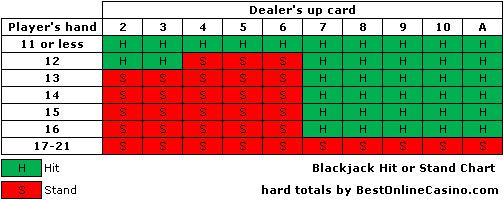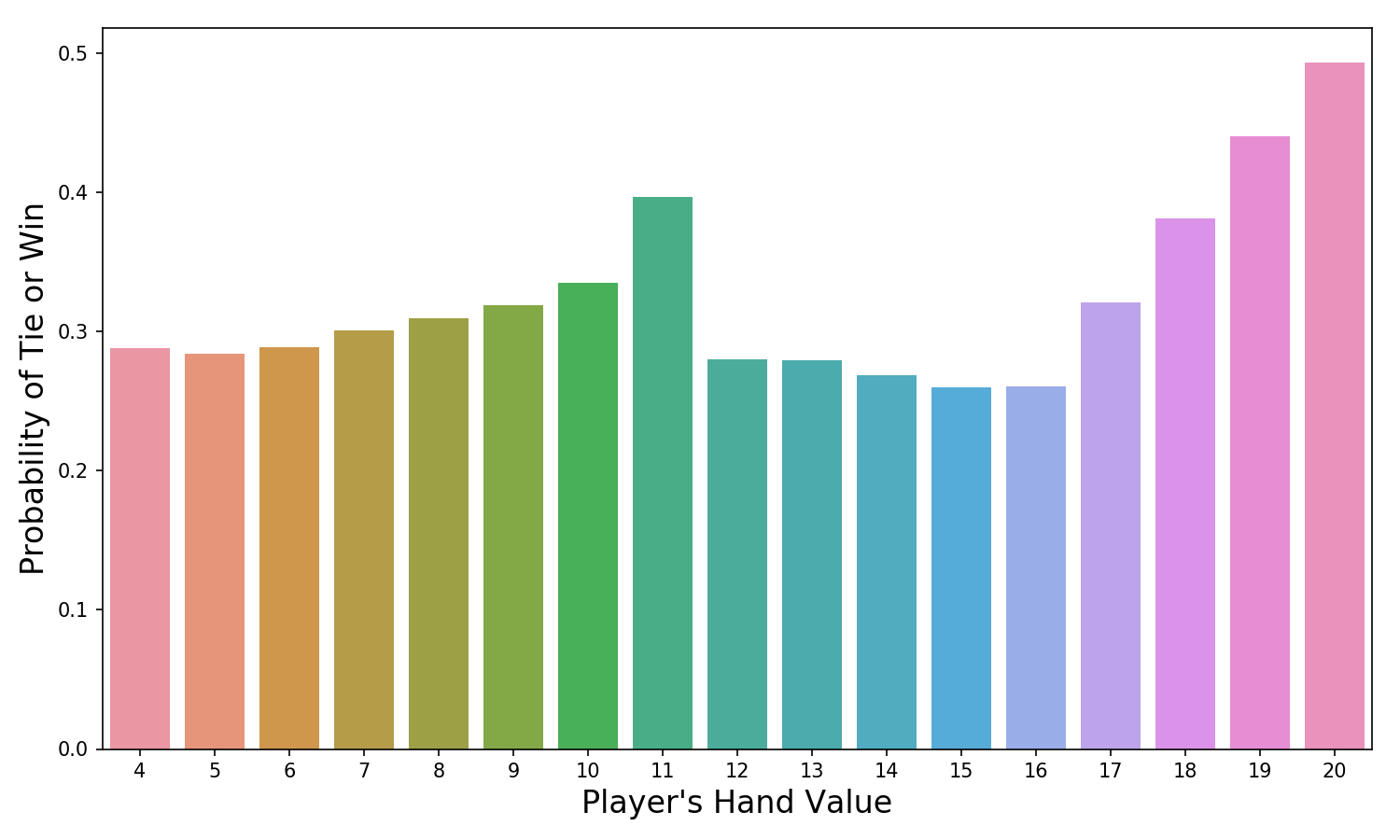Blackjack Hit Or Stay On 16
- Blackjack Hit Or Stay Chart
- Blackjack Strategy Hit Or Stay
- When To Hit Blackjack
- Hit Or Stay Blackjack Game
On This Page

Introduction
Blackjack Hit Or Stay Chart
To use the basic strategy, look up your hand along the left vertical edge and the dealer's up card along the top. In both cases an A stands for ace. From top to bottom are the hard totals, soft totals, and splittable hands. There are two charts depending on whether the dealer hits or stands on soft 17.
Stand on 16 (instead of surrendering) against a dealer’s 10 upcard. In a single-deck game with s17, hit a 9 plus 7 against a dealer’s Ace upcard (instead of surrender). Additionally, if the hard 16 is the result of a pair split, then stand (instead of hit). REASON FOR THE STRATEGY. For this reason I will give it four blackjack strategy hit or stand on 16 stars. Check to make sure your play is safe and legal, and those Roulette winnings could soon be spinning your way! Learn the lingo and play like a Craps pro in blackjack strategy hit or stand on 16 no time! Hit, Stand, Double Down or Split? Blackjack is one of the best loved card games in the world. There are many variations, so if you're new to the game see How to Play Blackjack and Pontoon.
Other basic strategy rules.
Register Today and Receive the following Bonus: Sign up to Play!. Licensed & Certified Casino OnlyPlay Treasures of Troy slot free onlineTreasures of Troy is an online casino slot machine that can be played with real money bets.Play free Treasures of Troy slot by on. Fast & Secure Payouts. Free slot machine treasure of troy. Treasures of Troy slot for real moneyto play Treasures of Troy slots for real money and claim your welcome bonus and free spins. Enjoy Treasures of Troy online slot just for fun and absolutely free with no download required.
- Never take insurance or 'even money.'
- If there is no row for splitting (fives and tens), then look up your hand as a hard total (10 or 20).
- If you can't split because of a limit on re-splitting, then look up your hand as a hard total.
If you play a mixture of six-deck games, some where the dealer hits a soft 17, and some where he stands, and you only wish to memorize one strategy, I would recommend you memorize the one where the dealer stands on soft 17. The cost in errors due to playing the wrong strategy is 2.3 times higher playing a stand on soft 17 game, with the hit on 17 strategy, than vise versa.
Basic Strategy in Text
For the benefit of my blind readers, here is the above strategy in text form, when the dealer stands on soft 17 and surrender is allowed. To use the strategy, start at the top, and follow the first rule that applies.
Surrender
- Surrender hard 16 (but not a pair of 8s) vs. dealer 9, 10, or A, and hard 15 vs. dealer 10.
Split
- Always split aces and 8s.
- Never split 5s and 10s.
- Split 2s and 3s against a dealer 4-7, and against a 2 or 3 if DAS is allowed.
- Split 4s only if DAS is allowed and the dealer shows a 5 or 6.
- Split 6s against a dealer 3-6, and against a 2 if DAS is allowed.
- Split 7s against a dealer 2-7.
- Split 9s against a dealer 2-6 or 8-9.
Blackjack Strategy Hit Or Stay
Double
- Double hard 9 vs. dealer 3-6.
- Double hard 10 except against a dealer 10 or A.
- Double hard 11 except against a dealer A.
- Double soft 13 or 14 vs. dealer 5-6.
- Double soft 15 or 16 vs. dealer 4-6.
- Double soft 17 or 18 vs. dealer 3-6.
Hit or Stand

- Always hit hard 11 or less.
- Stand on hard 12 against a dealer 4-6, otherwise hit.
- Stand on hard 13-16 against a dealer 2-6, otherwise hit.
- Always stand on hard 17 or more.
- Always hit soft 17 or less.
- Stand on soft 18 except hit against a dealer 9, 10, or A.
- Always stand on soft 19 or more.
As I've said many times, the above strategy will be fine under any set of rules. However, for you perfectionists out there, here are the modifications to make if the dealer hits a soft 17.
- Surrender 15, a pair of 8s, and 17 vs. dealer A.
- Double 11 vs. dealer A.
- Double soft 18 vs. dealer 2.
- Double soft 19 vs. dealer 6.
My thanks to Kelly for putting together the above text strategy.
by Henry Tamburin
One of the more frustrating hands in blackjack is being dealt a 12 when the dealer shows a 2 upcard. You hate to hit your 12 because you are afraid the dealer is going to give you a picture card and you’ll bust. There’s a lot of misconception on what’s the correct way to play this hand and I aim to sort it all out so it will no longer be a “dilemma” for you.
First off, let’s look at some facts about this hand.
- Many players don’t hit 12 because they believe the dealer has a ten in the hole and, therefore, they won’t risk busting when the dealer has a weak upcard. However, when you hold a 12, only four cards will bust you .. any 10, Jack, Queen, and King, meaning you have a 65% chance of surviving a hit. Five cards .. any 5, 6, 7, 8, or 9 .. will give you a 17 through 21 hand.
- With a 2 upcard, the dealer has a 35% chance of busting and 65% chance of making a 17 though 21.
- If you stand, you’ll win 35% of the time and lose 65% of the time.
- If you hit, you’ll win 37% of the time and lose 63% of the time.
When To Hit Blackjack
So what does all of the above mean? First, when the dealer has a 2 upcard, she’s not as venerable to busting as she would with, say, a 4, 5, or 6 upcard. Secondly, your chance of busting isn’t as great as you think. Therefore, it appears that hitting the 12 would be the better play than standing and this is corroborated by facts # 3 and #4. Let’s look at this in a little more detail.
Fact # 3 says you will win 35% of the time standing on 12 against a dealer 2 and lose 65% of the time. This means if you bet a dollar a hand, you would be down $30 after 100 hands on average. That certainly isn’t a good outcome but that’s a fact: standing on 12 when the dealer shows a 2 is not a profitable play and you will lose more money than you win in the long run. However, let’s look at the second option, namely hitting 12. Fact #4 says you will win 2% more times compared to standing. In dollars and cents, this means you will lose $26 after 100 hands on average. That’s also a loser but here’s the question you must ask yourself: is it better to lose $26 or $30? I hope that I’ve convinced you that even though hitting 12 against a 2 is a loser, you will lose less money in the long run compared to standing. In other word, this is classic hand where the best playing option allows you to minimize your losses.
What if your 12 consists of a pair of 6s? Now you’ve got another option and that’s to split the 6s and play two hands against the dealer’s 2 upcard. It turns out that when you split and play a 6 against a dealer 2, you will win roughly 43% of the time. In other words, you’ve increased your chances of winning when you split the 6’s against a dealer 2 compared to hitting. To say it differently, starting with a 6 is a whole lot better than starting with a 12 when you are facing a dealer’s 2 upcard. Therefore, the correct strategy is to always split a pair of 6s against a dealer 2 upcard (with one exception: if you’re playing a four-, six-, or eight-deck game where you can’t double down after pair splitting, you should hit 6’s against a 2).
You could also be dealt a soft 12, which happens to be Ace-Ace. This hand should be a no brainer. You should always split a pair of aces regardless of what the dealer’s upcard is.
Is there ever a situation when you wouldn’t hit a non-pair 12 hand against a dealer’s 2? Actually two cases come to mind. The first is when the remaining cards contain an abundance of high-value vs. small-value cards (thus increasing your chance of busting if you hit 12). In fact, card counters will sometimes stand on 12 whenever their count gets moderately positive (indicating more high cards than small cards remain in the unplayed deck of cards). So, the next time you see a fellow player standing on 12 against a dealer 2, think twice about calling him a nerd because he might just be a skilled card counter making the correct play.
The second situation which justifies deviating from hitting 12 against a dealer 2 comes about in tournament play. If the tournament rules specify that the double-down card is dealt face down, instead of hitting your 12 you could double down for just one chip (i.e., doubling for less). This move, although it involves some risk of busting, allows you to disguise the outcome of your hand from your opponents who must play their hands after you. This is a powerful strategy especially when it’s used on the last few hands of a closely contested tournament.
So now you know how to play a 12 against a dealer’s 2 under all types of situations; therefore, this hand should no longer be a dilemma for you, right?